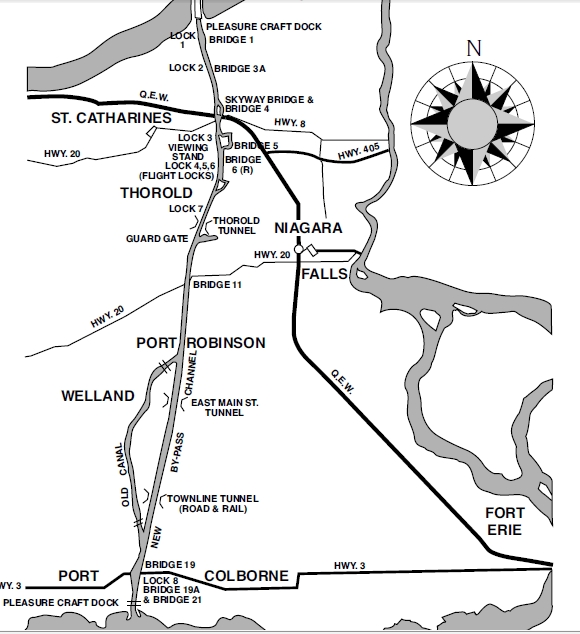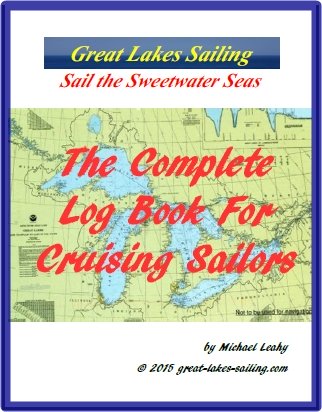Welland Canal
The Welland Canal connects Lake Ontario (at Port Weller) to Lake Erie (at Port Colbourne). The canal is 26 mi/42 km in length. The present canal is the fourth one to be constructed. There are 8 locks along the canal with 7 located in the northern half and a control lock at the south (Lake Erie) end. They are numbered from Lake Ontario to Lake Erie. Together, they raise or lover vessels 326.5 ft/99 m between the lakes. The average lift of locks 1-7 is 46.5 ft/14.2 m and 1-4 ft/.3-1.2 m.

Average transit time is about 12 hours. However, crews need to be prepared for longer times. Stopovers and partial transits are not permitted except in emergency situations.
The canal is a vital commercial link between the major industrial centres in the North American heartland plus the vast grain lands of the prairies and the markets of the world. Its economic impact is measured in the hundreds of millions of dollars and thousands of jobs.
Regulations (this summary includes extracts from the St. Lawrence Seaway “Pleasure Craft Guide” Only the Guide can be relied upon. A copy is available below.)
- Vessels must have a minimum deadweight of 1 Short Ton (2,000 pounds)/.9 Metric Tonnes (907 kg).
- Boats must be motor powered. A sailboat can't use its sails.
- A pleasure craft may not tow a dinghy – these must be stored on deck.
- A pleasure craft cannot lock through with vessels greater than 328 ft/100 m in length or those carrying oil or hazardous cargo.
- Pleasure craft greater than 65 ft/20 m must be equipped with a VHF radio capable of transmitting on channels 11, 12, 13, 14, 16, and 66A.
- In the Welland Canal, VHF Ch 14 is the Seaway working channel which should be used for scheduling and transit communications. Channel 16 is the international distress calling channel.
- Working channels for pleasure craft are VHF 8 and 16
- Radio operators must have licenses for their marine radios. (see section on Communications)
- All crew are required to wear personal flotation devices (pfd's) throughout the transit.
- Pleasure craft must have all of the required safety equipment
- Regulations require a minimum of 3 crew. For those with less, there are people who will provide this service for a fee.
Movement Regulations
(from the Seaway “Pleasure Craft Guide” Copy available below)
A system of navigation light signals and signs is in effect at all free-standing lift bridges in both the Montreal/Lake Ontario section and the Welland Canal. The system consists of a number of signals and signs as follows:
a) A red and green bridge navigation light display on the bridge span;
b) A limit of approach sign (L/A) - (red background, white letters, diamond shape);
c) A caution sign equipped with amber lights (yellow-black checkerboard, triangular shape); and
d) A whistle sign (yellow background, black lettering, square shape).
The flashing amber lights indicate that the bridge operator acknowledges that he has seen the approach of your craft and will commence the bridge operation. When the bridge starts to rise, the red bridge navigation lights will commence flashing. You should continue to approach to the limit of approach sign, but do not pass the L/A sign before the bridge span is fully raised and the green bridge navigation lights are displayed.
Do not pass the L/A sign until the span is fully raised and the green light is displayed. Pleasure craft should approach bridges as expeditiously as possible, observe the permitted speed limits and be governed by the light
Reporting in at the Locks
Upon arrival, proceed to the special docks for pleasure craft located near all locks at the Lake Erie and Lake Ontario ends of the Welland Canal. The use of any other Seaway docking facilities by pleasure craft is prohibited. A series of signs direct craft to each of these docks. Upon arrival, call the lock control using the dock telephone and you will receive your instructions. You will also be asked to provide the information requested in the instructions posted at the dock. Ensure that you purchase a ticket to pay for your lock transit.
Locking Through Signal Light System
A signal light system is provided at the approach to each lock to regulate the entry of vessels into the lock. The operation of pleasure craft entering the locks of the Welland Canal is also governed by this system. The system includes:
1. L/A Signs - The L/A signs are intended as an aid to vessel operators in approaching a lock as promptly as possible.
Their operation is as follows:
a) Limit of Approach No. 3 The L/A signs are equipped with red navigation lights only.
b) Limit of Approach No. 2 The L/A signs are equipped with red navigation lights only.
c) Limit of Approach No. 1 The L/A signs are equipped with red and green navigation lights.
The RED LIGHTS on the limit of approach signs have two characteristics:
i) Fixed — “Do not pass this L/A.”
ii) Flashing — “Stand by to cast off and move ahead to the next L/A sign displaying the navigation signal.” OR “Continue to approach, you will be able to pass this L/A soon.” NOTE: The L/A No. 1 red light will not start to flash until the last piece of equipment (gates, ship arrester or bridge) has started to open.
The GREEN LIGHT on the limit of approach sign has only one characteristic: Green - “Lock is ready for you.”
Lock Signal Light Panels
The purpose of the lock signal light panels, which are prominently displayed at each end of each lock is to assist vessel operators in timing their vessel movements for an optimum speed of entry and to indicate the state of readiness of the locks. The mode of operation of the lights indicates the dumping or filling of the lock, whether one or more vessels are in the lock and whether the approaching vessel will be handled next or held at the wall while the lock is turned back against it. The lights on these panels operate as follows:
a) The RED LIGHTS operate in conjunction with the associated limit of approach system and have identical characteristics, namely:
i) Fixed red - “Lock is occupied, do not pass illuminated L/A.”
ii) Red flashing together - “Lock is occupied by one vessel, do not pass illuminated L/A, but stand by to move into lock when outbound vessel has passed you.” OR “Lock is turning back for you, do not pass illuminated L/A but stand by to move into lock.”
iii) Red flashing alternately - “Lock is occupied by more than one vessel, do not pass illuminated L/A but stand by to move into lock when outbound vessels have passed you.”
b) Each illuminated AMBER LIGHT indicates two minutes of time while each flashing amber light indicates one minute of time. The lights will go out in sequence, starting from the top of the panel, with the last amber light being extinguished when the end of the lock becomes fully open.
- At Locks 1 to 7 inclusive, in the Welland Canal, the light timing sequence makes use of only two amber lights as follows:
- Two steady amber lights are shown 10 minutes before the lock end is fully opened.
- One steady and one flashing amber light are shown 7 1/2 minutes before the lock is fully opened.
- One steady amber light only shows 5 minutes before the lock is fully opened.
- A single flashing amber light shows 2 1/2 minutes before the lock is fully opened.
- When the two amber lights are extinguished, the lock is fully opened and the vessel can enter as soon as the green light is exhibited.
c) The GREEN navigation lights work in conjunction with the green light on L/A 1 and their only characteristic is: Fixed Green - “Lock is ready for you, enter as promptly as possible.”
Because of the higher incidence of water turbulence, all upbound pleasure craft transiting from Locks 1 to 7 on the Welland Canal must have a minimum of three (3) persons on board, i.e. one operator and two persons capable of tending the lines.
It is suggested that operators first contact marinas at Port Weller for needed additional manpower and, if unsuccessful, use the telephone located at the pleasure craft dock to request the assistance of the officer in charge.
Pleasure craft transiting the Welland Canal must maintain the order of passage when accompanying commercial vessels and adjust speeds accordingly. Transit time may exceed 12 hours and the crew should be prepared to man the craft continuously for that time. It should be noted that except for the approaches to Lock 1, upbound, and Lock 8, downbound, there are no pleasure craft docks throughout the canal. Partial transit of the canal is not permitted except in emergency cases, such as adverse weather or vessel malfunctions.
Pleasure craft approaching a lock should proceed to the Limit of Approach sign displaying a red light (steady or flashing), move into the lock when the navigation light shows green and follow instructions given by the officer in charge.
There is a ferry crossing at Port Robinson on the Welland Canal, near Nautical Mile 12.5. The wake from craft passing this area at excessive speeds can wash over the ferry boarding docks and splash waiting passengers. In order to prevent this, pleasure craft operators should keep within the maximum permitted speed of 6.0 kn (7 mph) which has been set for the area of the ferry crossing.
As of July 31, 2013, the tolls for the Welland Canal are $30.00 per lock (payable in either to Canadian or American funds). Payment is made at automatic ticket dispensers in full at either end of the Canal, by credit card only. Tickets are presented at Lock 3.
Click here for St. Lawrence Seaway “Pleasure Craft Guide”
Click here to return from Welland Canal to St Lawrence Seaway
Click here to return Home
The Complete Log Book For Cruising Sailors
written by a sailor for sailors

a practical, easy-to-use yet thorough format to record all of the necessary information about your boat and any cruises you take – whether exploring home waters or voyaging to distant ports across the Great Lakes.
.
Click here for more details